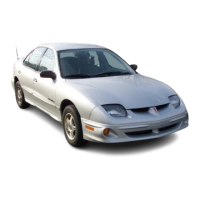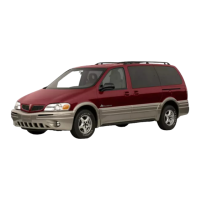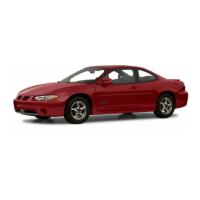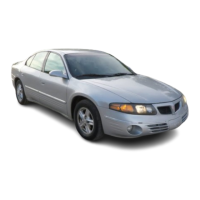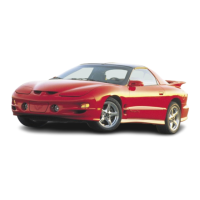
Do you have a question about the Pontiac 2001 Firebird and is the answer not in the manual?
| Brand | Pontiac |
|---|---|
| Model | 2001 Firebird |
| Category | Automobile |
| Language | English |
Explains safety cautions and symbols like CAUTION and the circle with a slash.
Details on adjusting manual and power seats, including lumbar support.
Guidance on proper safety belt usage and why they are important for everyone.
Instructions for adults on wearing lap-shoulder belts correctly.
Explanation of the air bag system and its function as a supplemental restraint.
Guidance on child safety restraints, including infants and older children.
Information on manual and power window operation, including caution about leaving children.
Details on manual and power door lock operation and lockout prevention.
How to use the remote keyless entry transmitter for locking and unlocking.
Explanation of the five ignition switch positions (ACC, LOCK, OFF, RUN, START).
Guidance on shift lever positions (PARK, NEUTRAL, DRIVE, etc.) and operation.
Instructions for operating 5-speed and 6-speed manual transmissions.
How to use cruise control, including setting, resuming, and safety cautions.
Overview of instrument panel components and their functions.
Explanation of various warning lights, gages, and indicators on the instrument panel.
Advice on being prepared and anticipating unexpected driving situations.
Information on alcohol's effects on driving ability and legal limits.
Explanation of braking action, reaction time, and stopping distances.
How the ABS system works to prevent skidding during braking.
Tips for safe driving in rain, including hydroplaning and brake performance.
Advice for increasing safety in city driving, focusing on traffic and signals.
Guidelines for safe freeway driving, including merging and lane changes.
Tips and advice for driving safely in winter conditions, including snow and ice.
Information on vehicle weight limits, capacity, and proper loading.
Guidelines for safely towing a trailer, including equipment and handling.
How to use hazard warning flashers to alert others and signal a problem.
Step-by-step instructions for safely jump starting a vehicle with jumper cables.
What to do if the engine overheats, including operating modes and precautions.
Instructions for safely changing a flat tire, including safety precautions.
Methods for freeing a stuck vehicle, focusing on caution and wheel spinning.
Information on gasoline types, octane ratings, and filling the fuel tank.
Guidance on checking and adding engine oil, including type and viscosity.
Instructions for checking and changing automatic transmission fluid.
Information on the cooling system, coolant types, and adding coolant.
Guidance on tire maintenance, inflation, wear, and buying new tires.
Tips for cleaning the vehicle's interior, exterior, fabric, and convertible top.
Location and importance of the VIN for vehicle identification and parts.
Information on vehicle fuse centers, types, and replacement procedures.
Schedule of recommended services based on mileage and driving conditions.
Checks and services owners can perform at specified intervals.
Inspections recommended for dealer or qualified service center.
List of recommended fluids and lubricants for vehicle maintenance.
A log to record service dates, mileage, and performed maintenance.
Overview of the Pontiac customer care philosophy and benefits.
Steps to follow for resolving concerns with dealerships and Pontiac.
Contact information for Pontiac customer assistance in the US and Canada.
Information on program for adaptive equipment reimbursement and resources.
Details on the roadside assistance program, services, and contact number.
Information on transportation options available during warranty repairs.
How to report safety defects to US government and Canadian government.
Information on ordering service manuals and other technical publications.

